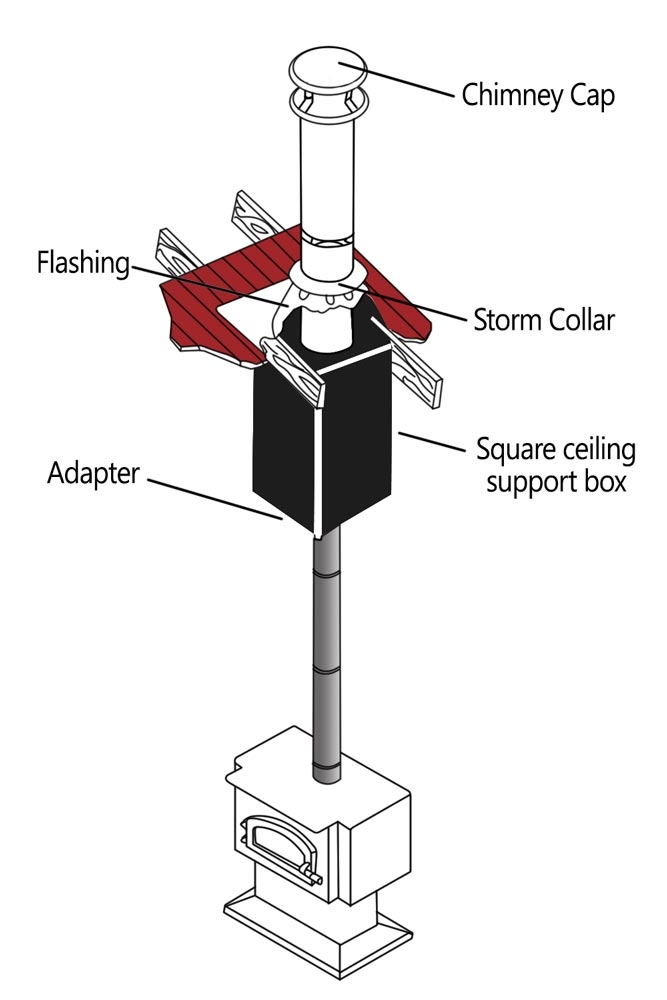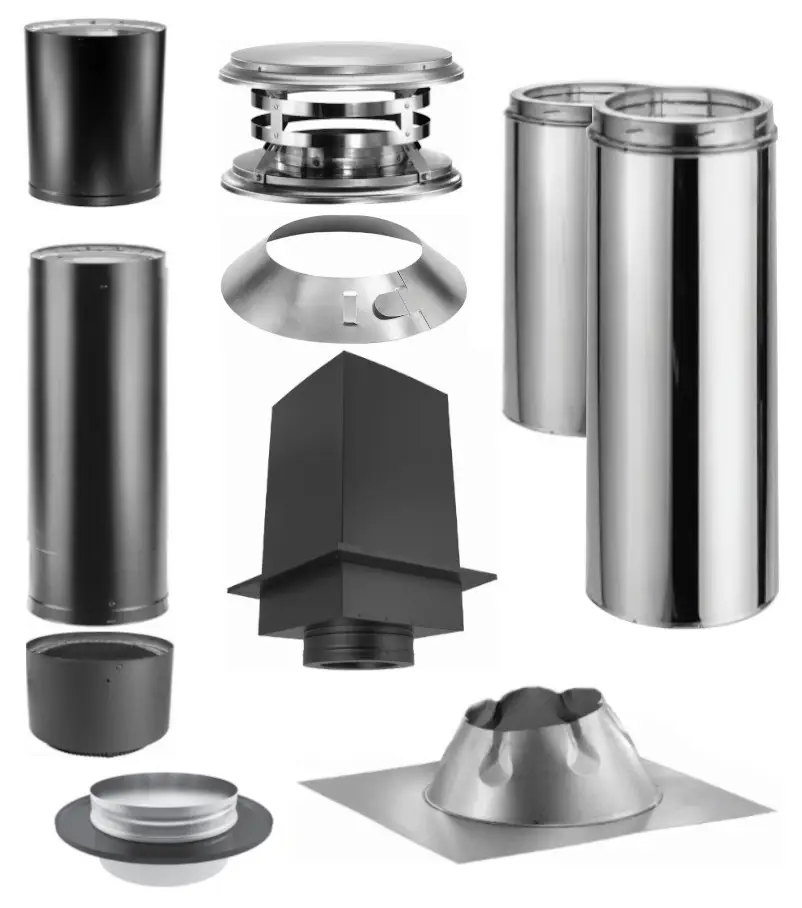When installing a wood-burning stove, ensuring safety and efficiency is paramount. One critical component of the installation process is the ceiling support box for wood burning stove. This essential piece plays a dual role: it supports the chimney system structurally and creates a safe passage for the stovepipe through the ceiling.

Whether you’re planning a new installation or upgrading an existing one, understanding the purpose and proper installation of a ceiling support box can make a significant difference in your stove’s performance and your home’s safety. This guide provides detailed insights into selecting, installing, and maintaining a ceiling support box.
Read too: Bathroom Flooded Through the Ceiling: A Comprehensive Guide
What Is a Ceiling Support Box for Wood Burning Stove?
A ceiling support box is a crucial part of a wood stove’s chimney system. It acts as both a support structure for the stovepipe and a barrier that protects combustible materials in the ceiling from the intense heat generated by the stove.
Key Functions:
- Structural Support: Holds the chimney pipe securely in place, especially in multi-story homes.
- Heat Protection: Maintains a safe distance between the hot chimney pipe and surrounding combustible materials, such as wood and insulation.
- Seamless Connection: Provides a transition point between the stovepipe and the chimney system.
Types of Ceiling Support Boxes
There are several types of ceiling support boxes available, each designed for specific installations.
1. Flat Ceiling Support Box
This is the most common type, designed for installations with flat ceilings. It is typically mounted between joists and allows the stovepipe to pass directly through the ceiling.
2. Cathedral Ceiling Support Box
Ideal for sloped or cathedral ceilings, this type accommodates the angle of the ceiling while still providing secure support for the chimney pipe.
3. Adjustable Support Box
These versatile boxes can be adjusted to fit various ceiling angles, making them suitable for both flat and sloped installations.
4. Decorative Support Boxes
Some support boxes come with decorative finishes, allowing them to blend seamlessly with the interior design of your room.
Why You Need a Ceiling Support Box for Wood Burning Stove
1. Ensures Safety
Without a support box, the intense heat from the stovepipe can pose a fire hazard. A properly installed support box prevents heat transfer to combustible materials.
2. Structural Integrity
It holds the chimney securely, reducing the risk of shifting or collapsing due to the pipe’s weight or external forces like wind.
3. Compliance with Building Codes
Most building codes require the installation of a ceiling support box for wood-burning stoves to ensure safety and efficiency.
4. Improved Performance
By maintaining a proper connection between the stove and chimney, a support box enhances draft performance, ensuring efficient burning and reduced smoke buildup.
How to Install a Ceiling Support Box for Wood Burning Stove
Installing a ceiling support box requires precision and adherence to safety guidelines. Below is a step-by-step guide:
Tools and Materials Needed:
- Measuring tape
- Screwdriver or drill
- Saw (for cutting ceiling material)
- Ceiling support box
- Chimney pipe
- Fire-rated caulk
Step-by-Step Instructions:
1. Choose the Right Support Box
Select a support box compatible with your ceiling type (flat or sloped) and chimney diameter.
2. Mark the Installation Spot
Use a measuring tape to locate the center of your stove’s flue pipe and mark the corresponding spot on the ceiling. Ensure the area is free of obstacles like electrical wiring or plumbing.
3. Cut the Ceiling Opening
Using the support box as a template, cut a hole in the ceiling. The opening should be slightly larger than the stovepipe diameter but within the support box’s specifications.
4. Install the Support Box
Secure the support box to the ceiling joists using screws or brackets provided in the installation kit. Ensure it is firmly anchored to bear the chimney’s weight.
5. Connect the Chimney Pipe
Insert the chimney pipe through the support box and attach it to the stovepipe. Seal any gaps with fire-rated caulk to prevent heat or smoke leaks.
6. Test for Stability
Ensure the support box and chimney are securely installed before using the stove.
Maintenance Tips for Ceiling Support Boxes
Regular maintenance is essential to ensure the longevity and safety of your ceiling support box.
1. Inspect Annually
Check the support box for any signs of damage, corrosion, or loose connections.
2. Clean the Chimney Regularly
A clean chimney reduces the risk of creosote buildup, which can cause chimney fires and affect the support box.
3. Seal Any Gaps
Over time, gaps may develop between the support box and the ceiling. Use fire-rated caulk to reseal them as needed.
4. Check for Heat Damage
Inspect surrounding ceiling materials for discoloration or warping, which may indicate excessive heat.
Common Mistakes to Avoid
1. Skipping the Support Box
Never install a wood-burning stove without a ceiling support box. It is a critical safety component.
2. Improper Sizing
Using a support box that doesn’t match your chimney diameter can lead to poor performance and safety risks.
3. Neglecting Local Building Codes
Always adhere to building codes and manufacturer guidelines to ensure compliance and avoid potential fines.
4. DIY Without Experience
If you’re unsure about installation, hire a professional to avoid mistakes that could compromise safety.
FAQs: Ceiling Support Box for Wood Burning Stove
1. Can I install a wood stove without a ceiling support box?
No, a ceiling support box is essential for safety and structural integrity.
2. How do I choose the right size support box?
Refer to your stove and chimney specifications to select a support box that matches the chimney diameter and ceiling type.
3. Are ceiling support boxes universal?
No, support boxes vary in design and size. Ensure compatibility with your stove and chimney system.
4. Can I install a support box on a cathedral ceiling?
Yes, cathedral ceiling support boxes are specifically designed for sloped ceilings.
Conclusion
A ceiling support box for wood burning stove is a vital component that ensures safety, functionality, and compliance with building codes. Whether you’re installing a new wood stove or upgrading an existing setup, investing in the right support box is crucial for long-term performance and peace of mind.
By understanding the types, installation process, and maintenance tips, you can make informed decisions and enjoy the warmth and charm of a wood-burning stove in your home.

